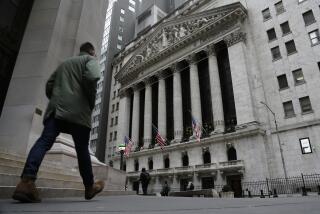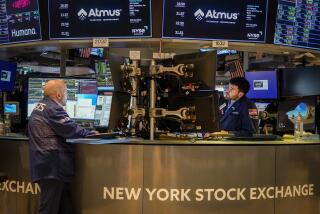Are Bonds Trying to Spell Out the Dreaded R-Word?
- Share via
The latest plunge in bond yields--and the surge in stocks--has been popularly viewed as Wall Street’s advance celebration of a balanced federal budget.
But some analysts say the bond market may now be focused less on a budget accord than on a more pressing concern: a surprisingly weak U.S. economy that may get much weaker.
“Clearly the risk to the economy is on the downside, not the upside,” warns Sung Wohn Sohn, chief economist at Norwest Corp. in Minneapolis.
And while a stumbling economy could lead to even lower interest rates, the soaring stock market’s ability to weather dangerously low growth and potentially disappointing corporate earnings is uncertain at best.
So far those fears remain in the background: The Dow Jones industrials hit another record Tuesday, rising 37.93 points to 5,177.45.
Long-term bond yields, which had dipped to 25-month lows Monday, inched up slightly Tuesday, with the 30-year Treasury bond closing at 6.04%, compared with 6.02% on Monday.
Still, the bond market’s rally in recent weeks has been so dramatic that yields on Treasury securities as long as 10 years in maturity now are below the Federal Reserve Board’s benchmark short-term interest rate, the overnight “federal funds” rate, which the Fed is holding at about 5.75%.
Normally, you’d expect the cost of money to rise with the length of time the funds are at risk. In other words, long-term yields should be higher than short-term yields. So the current shape of the “yield curve” suggests that short-term yields must come down sharply. And the only way for that to occur is for the Fed to cut rates aggressively, something it typically does only when the nation is in danger of recession.
Is that what the bond market is telegraphing--a shrinking economy? Most analysts aren’t ready to use the R-word quite yet, but many admit that the evidence is mounting that the economy may be much slower this quarter and in the first half of 1996 than now anticipated.
Retail sales this Christmas season have been disappointing, car sales continue to decline, and the housing market nationwide is slumping again even though mortgage rates are at 22-month lows.
Edward Yardeni, economist at Deutsche Morgan Grenfell/C.J. Lawrence, also notes that manufacturing activity has contracted for four straight months, as measured by the National Assn. of Purchasing Management’s closely watched index.
*
What’s more, the Fed’s own key measures of growth in the nation’s money supply have been falling or stagnant in recent months. Historically, that’s predictive of a weakening economy, because it suggests falling demand for the basic fuel that makes the economy go.
Joseph Carson, economist at Dean Witter Reynolds, believes that U.S. business activity is waning so quickly that fourth-quarter growth in real gross domestic product will be a mere 1.4%, far below the 2.4% consensus estimate of economists surveyed by Eggert/Blue Chip Consensus newsletter.
Even though 1.4% would still represent real growth, the risk at such a slow pace of expansion is that any major shock (such as some international event) could push the economy into recession.
Yet some experts still argue that bond investors aren’t saying as much about the economy’s prospects as they are about the odds for a balanced budget in Washington and the long-term outlook for continued low inflation--one of the important potential bonuses of a deficit-free Uncle Sam.
“The bond market is believing in [inflation] stability,” and rightly so, contends Irwin Kellner, economist at Chemical Bank in New York. That is why long-term yields are coming down and can continue to come down even if economic growth picks up as expected in 1996, he says.
And there are plenty of analysts who insist that the economy’s current weakness is temporary, just as recession worries last spring proved overblown. Gordon Richards, chief economist at the National Assn. of Manufacturers, sees GDP growth at 2.8% in 1996, helped by an expected new boom in U.S. exports and by lower interest rates.
Kellner concedes that the stock market, at record highs, has made a huge bet that the bond market is not in fact heralding a significantly weaker economy. Corporate profits, which were expected to slow in 1996 under the best of circumstances, could collapse if the economy tanks, undercutting stocks.
Even at a moderate growth pace, with inflation subdued “it will be increasingly tough for [companies] to live up to Wall Street’s earnings expectations,” Kellner warns. If earnings disappoint, stocks will be supported only by the belief that the Fed will continue to lower rates. With the Dow already up 1,300 points this year, that’s a heavy weight for a one-legged stool.
(BEGIN TEXT OF INFOBOX / INFOGRAPHIC)
Market Leads Fed
Yields on all but the longest-term Treasury bonds have already fallen sharply below the Federal Reserve Board’s benchmark short-term interest rate, the federal funds rate, now 5.75%. That means the market is effectively demanding a Fed rate cut. Treasury yields, by maturity:
Fed. funds: 5.75%
3-month: 5.48%
1-year: 5.35%
2-year: 5.32%
5-year: 5.47%
10-year: 5.68%
30-year: 6.04%
Source: Times reports
More to Read
Inside the business of entertainment
The Wide Shot brings you news, analysis and insights on everything from streaming wars to production — and what it all means for the future.
You may occasionally receive promotional content from the Los Angeles Times.










